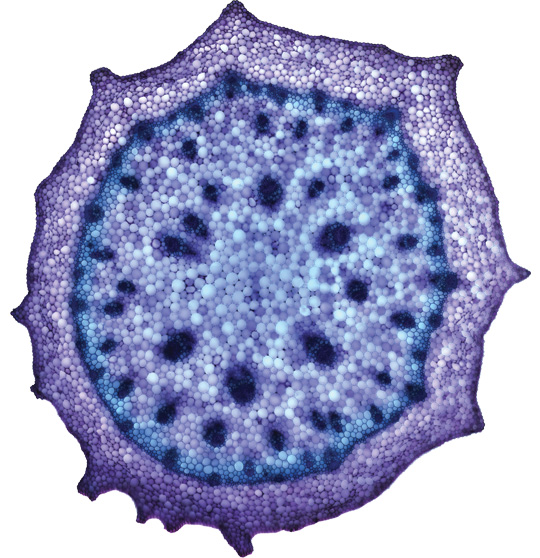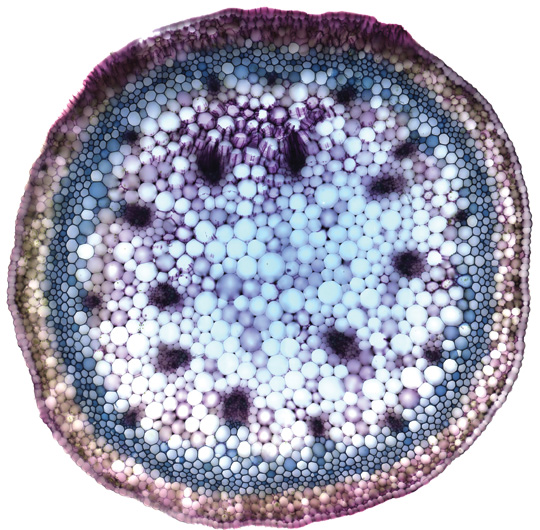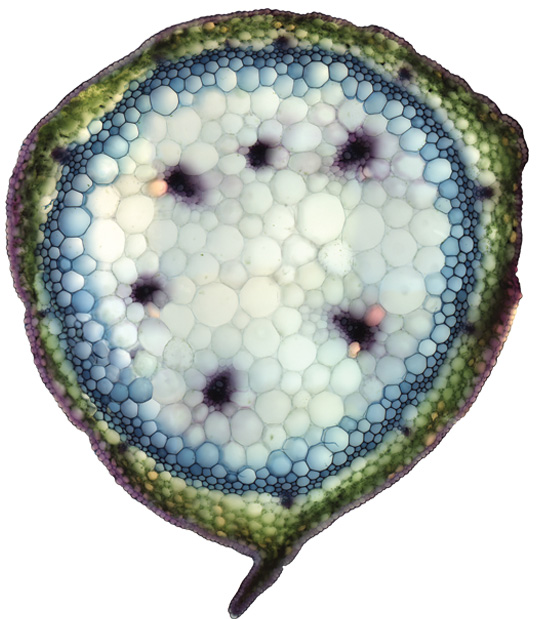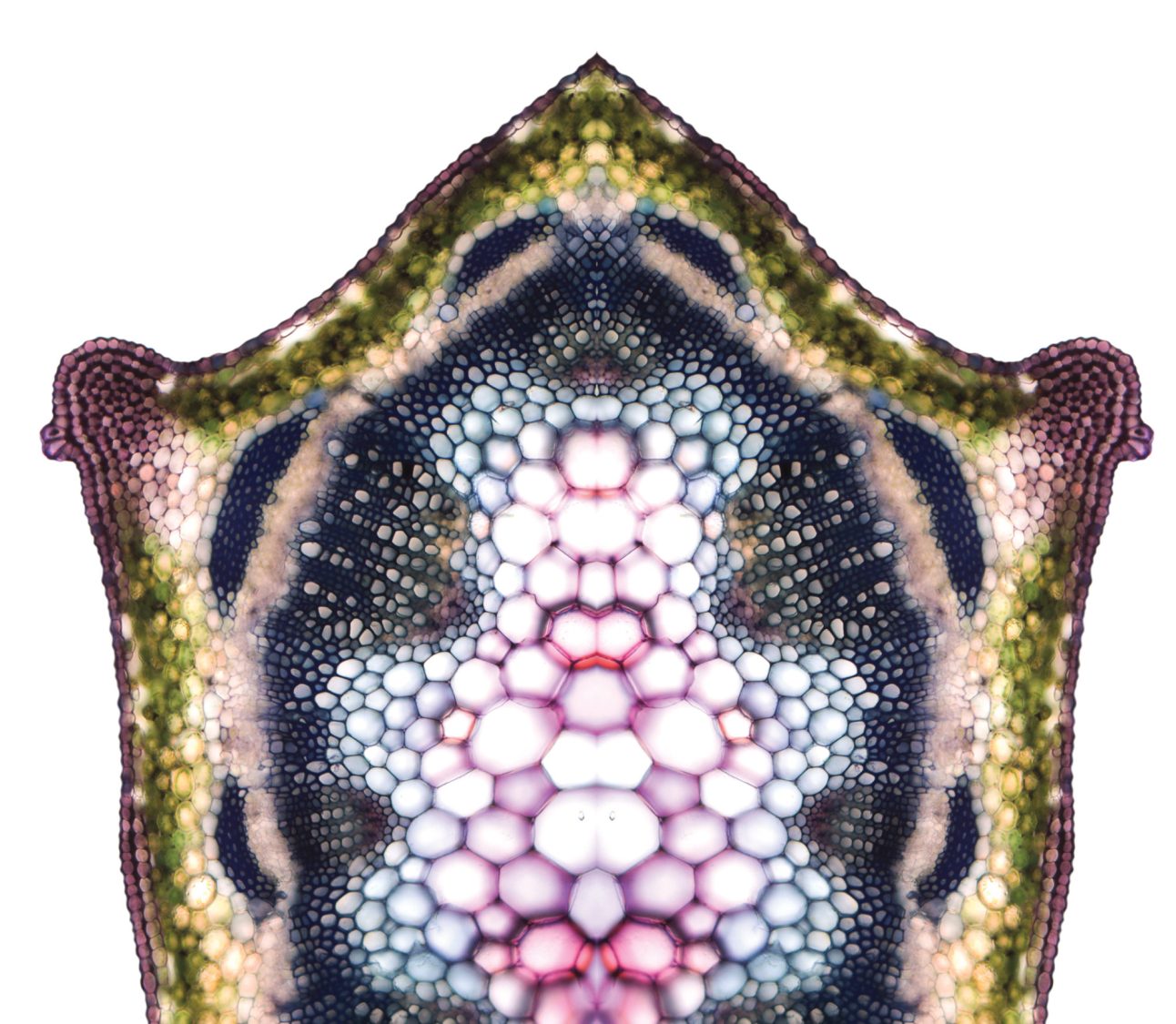It is the size of a pea, and crisp green. Feel it in your fingers: the packed potential within its smooth borders; the tight, pinprick tip—that searching extension of sentience. Put it into the earth with me. Black mineral loam, juicy, flecked with bits of organic energy; arms from underground, waiting for our baby seed. Let’s spend a few weeks with it underground. Plant the seed in your imagination. Earth presses up against it; caressing it . . . it draws the earth into itself. The soil offers its minerals to the seed. Seed and soil flowing into one another.
A fundamental law of nature: for the right mate, all precincts are porous. Moisture pierces the seed’s green skin, much to its joy. Sun bakes through the soil, heats the love inside our seed. Carbon dioxide from the air clicks into another mode inside the seed, wakes up newly when it wanders within and meets the family of factors gathered there. Who’s in charge here? Is the seed co-opting its environment? Is the outside world invading the world inside our seed? There is a party going on inside there. An orgy. Nobody knows any better. All of nature is naked inside that seed; elements are uniting, reconfiguring, something new is arising.
It’s all coming together—upside down and inside out.
The seed can be looked at in and of itself. Or it can be seen as a point in a process. Sitting quietly, breathing, inside and outside interpenetrating, we come up against similar wonderings. Where does one thing end and another begin? Contemplation involves slowing the mind down, taking it into the breath, until it manifests the natural rhythms of life itself, and no longer needs to grasp at the fruit of mental energy; you are down in the soil where thoughts grow, arise, die away. The foundation. The source. Giving rise to the ten thousand things, the whole manifest universe. I often contemplate the seed of our cosmos, which scientists tell us was very small and dense and hot: we were all packed in there together back in the day. Our minds and genitals and bank accounts and families were fused as one. Then there was an explosion, and we were torn apart. Our basic DNA is stardust, cosmologists tell us. We then grew arms and eardrums to connect once again; blood gurgled up to lubricate our movements; we grew feet to walk toward each other; retinas to take each other in; fingers to pick lice from each others’ coats of hair, and to slide rings onto one another.
We are designed to come back together once more, and we all exploded outward way back when so that we could begin the long, slow climb back into each other’s arms. Without distance, without being apart, we could never then become one. If we were still packed together in that infinitesimally dense cosmic seed, where your lung was my hand and my thoughts were your blood, we could never bear witness to oneness, which is a beautiful thing and deserves an audience. Things flow into each other and back to themselves, gaining themselves through the other and the other through themselves. It’s natural. Everything falls into its proper place after spending some time apart. “We just fit together,” a female lover told me years ago. “It’s perfect.” We had just made love, which is to say we had forgotten ourselves by way of each other, as only two young souls filled to bursting with themselves can.

Recently, I spent some time with a tiny baby girl, and this was her process: she touched her surroundings with her eyes, blinking often to clear the way for more receiving. She used her chubby fingers to grope the air and pat-pat-pat the wooden floor. She pivoted on her squat little butt, an empress, the earth beneath her, her throne. She produced sounds that filled our ears. It was the sound of a seed pushing through soil. She grew very fast, before our eyes, in just a couple of hours. Along the way she often became fed up with this process and started sobbing.
Enough already! I’d like to stay the same, if you don’t mind! I’d rather not have to grow up!
But, of course, not growing up is not an option. You have to grow, little girl. It’s what you do. So the tears come, the agony of arising. Growing pains. The tears and trembles wash and shake her clean. Into her mother’s arms she goes, and we all turn back to each other and share adult conversation and go to the bathroom and sip our tea, and then ten minutes later, there she is back on the bamboo floor again, lips damp and belly bubbling with breast milk. Only she is a little older now. Dead from a few minutes before, and reborn. Extending a little further out of herself, finding fresh faces to explore, reaching out and touching, fiddling with our lips, like a harpist plucking song from strings. Digesting something new from her surroundings, she turns it into the food of experience, and then interacts in a fresh way with her surroundings.
We laugh our asses off. We call this “playing.”
What I won’t forget are her big, global eyes, swirling white and sapphire and fresh from tears, as teeming and tight as the tiny green seed.
I’ve lived at a Zen Buddhist monastery for nearly a decade, and here’s what I’ve learned to have faith in: outside of me, there is a perfect home for everything inside of me. And inside of me, there is a perfect home for everything outside of me. Just let it go, and let it in. In and out, like the breath. After all, outside has nowhere to go but in, and inside has nowhere to go but out. My job, our job, is to broker the exchange between the two, to manifest the interpenetration of inside and outside, of self and other. That’s all. I dissolve in activity, in relationship with my surroundings, so that the inner world can flow out, and the outer world can arrive within. I have to both put in effort and know when to let go. There’s a natural balance, a dance, between embracing and releasing: turning your surroundings into yourself, like the tree that absorbs carbon dioxide, and turning yourself into your surroundings, like the same tree releasing oxygen.
This is what Buddhists call the Middle Way.
I am sometimes asked how I’ve changed in my career as a full-time Zen monk. Often the question is pretty pointed. Young students want to know what they’re getting into. Before taking up Zen, I was like a seed that, upon being introduced to minerals, water, oxygen, and sunlight, says something like, “Oh no, thank you, but I’d rather not have you permeate my borders and transform me from within. That’s a little much. I have my boundaries. I don’t want to let the world in. And I surely don’t want to release the best part of myself back to the world. I’m a seed, after all. I want to become a bigger seed, you see, not something else, like a plant or a bush or mulberry tree.”

Yet my very cells, stacked and hollow, ached for input; and the wiggle and flow within pressed against my borders for release. I needed to grow. Hunched, scowling, unsure of everything, I walked around like a question mark, which, if you think about it, looks like half of a heart too firmly upright. Slant a little! Slide into the arms of the world around you! Meet your match, which is always coming from the other way!
What’s the best part of you? Your heart. What happens if you don’t feed it? It grumbles and, like an empty stomach, eats away at you. Do you imagine that the rest of you doesn’t operate on the exact same principle as the best part of you? Your very being, all its parts, and the sum of you that is greater than those parts, amount to nothing more than unrequited love, an open womb, soft earth, into which your surroundings plant seeds, so that your fulfillment gradually manifests as seeds that fit perfectly with your surroundings. As our environment cultivates us, we cultivate our environment.
When we sit Zen meditation, we manifest oneness with our surroundings. We don’t go anywhere or do anything. We don’t take flights of mental fancy or work ourselves into a spiritual fervor. We sink down in our seat. We don’t wear earplugs. And we keep our eyes open, with a soft gaze. Our spines are straight, our minds are clear, our hearts are open. Our whole body comes alive through stillness.
“Where are you when you see the flower?” my teacher would ask, over and over, during our private meetings.
I would turn to the vase of flowers and furrow my brow, waiting for an answer. Those flowers were implacable: their petals were practically crossed, like a pair of arms. They didn’t budge. I’m over here and they’re over there, my mind concluded. And never the twain shall meet.
One day, when, for whatever reason, I didn’t get a chance to think about it, I took the flowers in, and smiled. I bloomed along with the flowers. How the flowers went from that vase to my lips is a miracle. Let me unpack the miracle: I realized that the life in the flowers and the life in me are the same life. We are two halves of one experience. The flowers took root within me and blossomed, because we were never fundamentally separate. We were within each other all along. We occupy one cosmos together.
We are never more than a breath away from the home we share with the entire universe. Zen meditation is just us checking back in. “Hi honey, I’m home; hi honey, I’m home,” over and over. We are still hugged together as closely as we were back in the days of the cosmic seed.
So why bother separating in the first place? we sometimes ask, struggling to hold down our corner of the cosmos in the meditation hall.
And sometimes the universe answers: I needed to give myself some room to breathe. But don’t worry, in the blink of an eye we’ ll all be back together again.
During these moments, we often wish the universe had kept its big fat mouth shut. We don’t like being reminded of the reunion that awaits us. We’re designed to fall in love with our short time on this planet, where there is room enough for all of us to breathe.
When I first moved to the monastery, I hated it. I didn’t get it. I felt its goodness, sure: my bones knew I was in the right place, but my mind was like, Get me the hell out of here! The environment was trying to work on me, to get in there, the way soil works on a seed; I preferred to stay young and green. Seed-wise, I wanted to stay in my packet. I didn’t want to grow. I spent my days off in the computer room, visiting a website I like to call evilzen.com. I read essay after essay about how corrupt and backward American Zen Buddhist practice had become. I loved it. It hit the spot, all this negativity. At one point I contacted the owner of the website, and we began a correspondence. He urged me to leave the monastery.
“Get on with your life! You’re running away from reality up on that mountain!” he said.
I took his prickly words to heart, but my heart was strangely unmoved. I’d planted my roots in that mountain soil, and I couldn’t seem to budge. I talked a lot, to anyone who would listen, about leaving, but every morning I woke up at four, scuttled off to the meditation hall, and sat and breathed.
One day I repaired to the tech cabin, booted up the student computer, waited several hours for the infernally archaic machine to finally produce a web browser, and went to type in evilzen.com. That’s when my jaw went slack and fell to the snow-wet carpet and stayed there. This was in 2004, a day after Christmas. The home page hosted a breaking story. A tsunami had hit Southeast Asia. I remember the figure: 283,000 dead. A massive sinkhole of meaning and hope had opened up halfway around the world. I sat there for a very long time becoming acquainted with the horror through photos. A gray dog with no discernible head washed up against the side of a torn-apart house. Grandmothers, children, mustached men, and wild-haired wives—photo after photo . . . click, click, click . . . everyone with the same expression, mouths and eyes circular, just screaming and screaming in agony.
I remember thinking three things, and scribbling them in my journal, reproduced here verbatim:
- My worries here on the mountaintop are insignificant in comparison to what 90 percent of humanity has to deal with. Do the words QUALITY PROBLEMS mean any thing to you, white boy??
- One sentence: Life is not fair.
- If I leave this mountaintop, whatever I am running away from up here, I will have to face down there. You cannot escape the problem of living. You cannot escape the human condition.

And this is where it gets hard. Everyone understands that a seed must let the world in so that it can grow, and truth be told, the seed doesn’t seem to mind. And everyone more or less gets that the baby’s tears water its own little green shoots and roots; pain is part of her growing process. There, there, we say, burping her on our shoulder. It’s okay. When it comes to babies and seeds, we get it. No problem. But what about when the same natural process that gives rise to and nurtures us destroys us indiscriminately, brutally, violently? What about when our daughters are raped, our jobs are lost, our cars crash, and our brain chemicals go haywire? What about when our surroundings turn on us, and swallow us whole, like the ocean that swallowed those 283,000 people?
I don’t believe in spirits, but that doesn’t mean they’re not out there. Seven years ago, when a mechanism lowered my grandmother’s shiny black casket into the earth—click, click, click— my 30-year-old cousin started sobbing. This set off a chain-reaction, and nearly all of my ten little nieces and nephews joined in. Their tears watered the air, brought it alive. I thought I heard my grandmother’s ancient voice then: “Life is precious because it ends. If it went on and on and on forever, it would be very cheap indeed.” Spoken like a true Depression Era baby, who knew the value of things, and even repurposed every last piece of junk mail as scrap paper.
Her final days were not entirely pretty, and I often contemplate them on the cushion. She became incontinent: there was shit smeared on most of the chairs in her apartment, where she lived alone. Apparently, she ate only bite-size candy bars those final few weeks of her life. When my mother arrived after getting the call, and saw her mother’s dead body, she screamed and screamed for a Catholic priest. Something shorted inside her head, and she lost all but 30 percent of her hearing in one ear.
It’s easy to understand what a seed or a baby is going through, but it’s hard to extend our appreciation to the corpses of loved ones, and tsunamis. Life is precious; we hate to see it go. But if it went on and on, ours would be a horrible universe. There would be infinite darkness into and from which our lives grew and grew. We would become impossibly ancient, losing all sensitivity; we would no longer be able to feel love, or taste food, like my grandma, who in the end subsisted simply on sugar highs. We would be like those Guinness World Record holders who grow their fingernails out into dense, gnarled, tortuous tree roots—only not just our fingernails but every aspect of our selves would spread, swell, twist in on us in unruly patterns, making the simplest daily rituals a hellish nightmare. I would certainly take up smoking again, and smoke and smoke and smoke, spending whole centuries under a bridge, smoking and masturbating and picking off sewer rats with a handgun. I certainly wouldn’t do anything good with my interminable life. What would be the point?
Where there is no death (and there is nowhere where there is no death, except maybe vampire novels), there are no risks, and life is utterly meaningless.
Life is precious, and so death must be precious too. Our job is to figure out why. So we sit on our cushions and breathe. One breath ends, the next begins. We sink down into the earth, where the inhale and the exhale meet—head into each other—exchange positions, dying over and over for each other: giving life to us, like the seed that dies in order to become a tree. We’re dying and being reborn every instant of our lives—blink, and your 21st birthday becomes your 70th, your dimples now wrinkles, your face a map of everywhere you’ve been and all you’ve done in that blink of an eye.
One experience ends, the next begins, but nothing really changes. We’re still packed inside that cosmic seed together. We simply have a little more room to breathe. But don’t worry: we’re coming back together. Each day, we’re getting closer and closer to the source, and each other. Try to not be afraid, and I’ll try along with you. Let’s practice the dark celebration of mourning, and release, on the cushion and in our lives. We are part of a process, and eventually the momentum, like the inhale or exhale, will shift the other way. Perhaps death is merely the negative image, or reverse process, of life. The same thing heading the opposite way. One universe, differently emphasized.
As I finish this, the sun is setting overhead, which means it’s rising somewhere else. A jet is gurgling across the sky, going from here to there, and back again. Snow floats down from that same sky, where it will return once more with the spring thaw. Everything is as it should be . . . except for me, and maybe you.
But don’t worry, we’re getting there too.
Thank you for subscribing to Tricycle! As a nonprofit, we depend on readers like you to keep Buddhist teachings and practices widely available.
